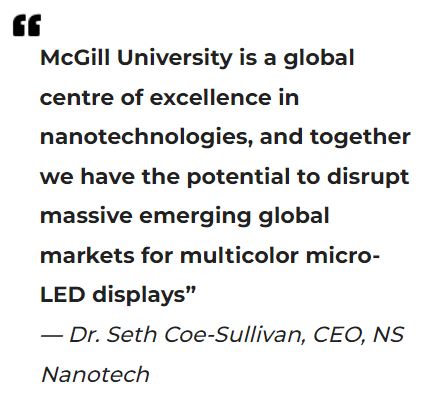
New Montréal-based R&D centre will leverage exclusive licenses to nanoLED technology patents held by McGill University for next-generation displays
McGill University is a global centre of excellence in nanotechnologies, and together we have the potential to disrupt massive emerging global markets for multicolor micro-LED displays”— Dr. Seth Coe-Sullivan, CEO, NS NanotechMONTREAL, QUEBEC, CANADA, March 2, 2023 /EINPresswire.com/ -- NS Nanotech announced the formation of NS Nanotech Canada in Montréal, Québec, an R&D centre focused on advanced research to enable commercialization of next-generation nanoLED technologies for televisions, mobile phones, smart watches, augmented-reality headsets, and other applications. Leveraging exclusive licenses to a portfolio of groundbreaking patents owned by McGill University, the research centre will further NS Nanotech’s long-term mission to develop the world’s first efficient sub-micron-scale nanoLEDs.
 Based in Ann Arbor, Michigan, NS Nanotech is developing next-generation technologies for large displays, microdisplays, and ultraviolet UVC disinfection applications including COVID-19 prevention. NS Nanotech Canada signed an initial agreement with McGill University to start collaboration with top research scientists there including Prof. Songrui Zhao, one of the world’s leading nanoLED researchers. Prof. Zhao holds numerous patents and is advancing the state of the art in molecular beam epitaxy and other foundational technologies designed to enable orders-of-magnitude improvements in costs and efficiency over today’s LEDs.
Based in Ann Arbor, Michigan, NS Nanotech is developing next-generation technologies for large displays, microdisplays, and ultraviolet UVC disinfection applications including COVID-19 prevention. NS Nanotech Canada signed an initial agreement with McGill University to start collaboration with top research scientists there including Prof. Songrui Zhao, one of the world’s leading nanoLED researchers. Prof. Zhao holds numerous patents and is advancing the state of the art in molecular beam epitaxy and other foundational technologies designed to enable orders-of-magnitude improvements in costs and efficiency over today’s LEDs.
“The $120-billion global display market is based on 20th-century technologies limited by several major shortfalls in cost and performance that NS Nanotech is working to overcome,” said Dr. Seth Coe-Sullivan, CEO and co-founder of NS Nanotech. “McGill University is a global centre of excellence in nanotechnologies that confront these shortfalls head on, and together we have the potential to disrupt massive emerging global markets for multicolor micro-LED displays and UVC-LED disinfection solutions.”
Derrick Wong, MSc-MBA, a part-time lecturer and mentor at McGill University, is the newly appointed Chief Operating Officer at NS Nanotech Canada, and the Senior Research Scientist is Dr. David Laleyan, a McGill graduate who received his Ph.D. from the University of Michigan in 2020. The company intends to add several additional researchers this year for continuing collaborations with McGill University in 2023 and beyond.
Support from industrial development authorities:
Montréal International and Investissement Québec have supported NS Nanotech in its Montréal expansion.
“The semiconductor industry is highly strategic, and we are proud to contribute to its growth in Greater Montréal by supporting NS Nanotech’s Montréal project,” said Alexandre Lagarde, Vice-President, Foreign Investment at Montréal International. “The new research centre demonstrates the unique appeal that our researchers and post-secondary institutions, such as McGill University, represent for investors developing key projects. Furthermore, our highly qualified talent pool, particularly in STEMs and artificial intelligence, are key to the development of nanotechnologies.”
“Investissement Québec International is pleased that NS Nanotech has decided to establish itself in Montreal and to partner with McGill University in their research projects to develop more efficient nanoLED technologies with potential concrete applications in a variety of fields,” said Hubert Bolduc, President of Investissement Québec International. “The establishment of NS Nanotech Canada demonstrates the attractiveness of Quebéc in the field of semiconductor technologies, and our teams are proud to have supported them in their implantation process.”
Size matters: submicron nanoLEDs are (much) smaller than a strand of human hair:
In its laboratory research, NS Nanotech has created samples of submicron-sized LEDs that are radically smaller than any other LEDs available in the world today. A micron is a millionth of a meter or one seventieth the width of an average strand of human hair.
Conventional LEDs are larger than 200 microns, and today’s “mini-LEDs” are generally between 100 and 200 microns. New “micro-LEDs” are smaller than 100 microns, but NS Nanotech’s laboratory nanoLEDs are smaller than one micron. Potential applications for nanoLEDs include large displays as well as lightweight augmented reality eyeglasses incorporating full-color microdisplays. NanoLEDs can also be tuned to emit invisible light in the very short ultraviolet wavelength range which has been proven effective in safely deactivating SARS-COV-2 viruses and numerous other pathogens.
“Because smaller LEDs equate to lower costs and higher resolution, successful commercial production of the first true nano-scale LEDs will be transformational,” said Coe-Sullivan. “Having an R&D team of LED experts in Montréal who can collaborate with the world-class researchers at McGill University will help accelerate development and delivery of nanoLEDs to a vast array of markets in the coming years.”
TrendForce 2022 Deep UV LED Application Market and Branding Strategies
Release: 25 April 2022
Language: Traditional Chinese / English
Format: PDF / EXCEL
Page: 149
Release date: 31 May 2022 / 30 November 2022
Format: PDF
Languages: Tradional Chinese / English
Pages : 130–150 in total (subject to change)
|
If you would like to know more details , please contact:
|





 CN
TW
EN
CN
TW
EN





